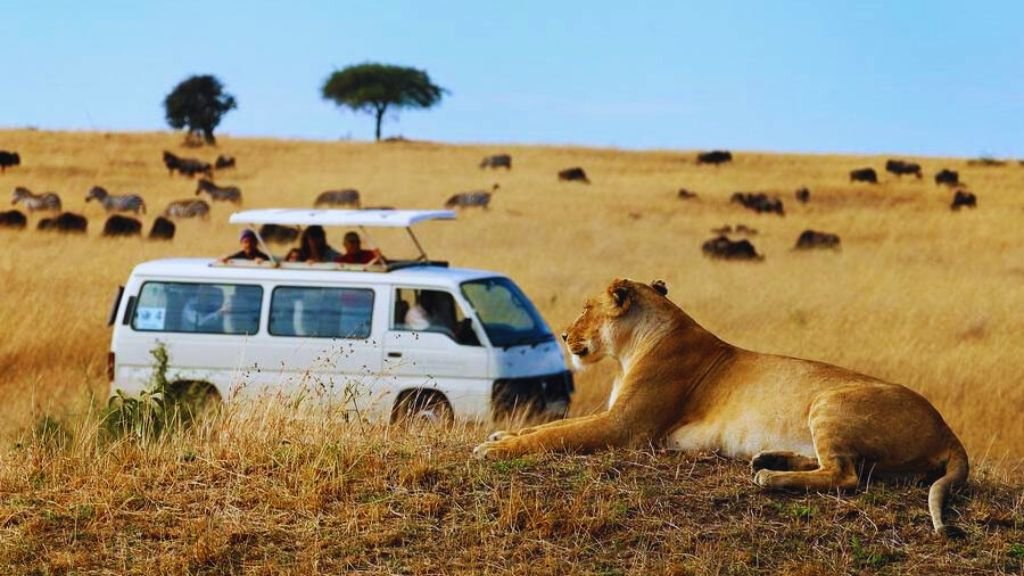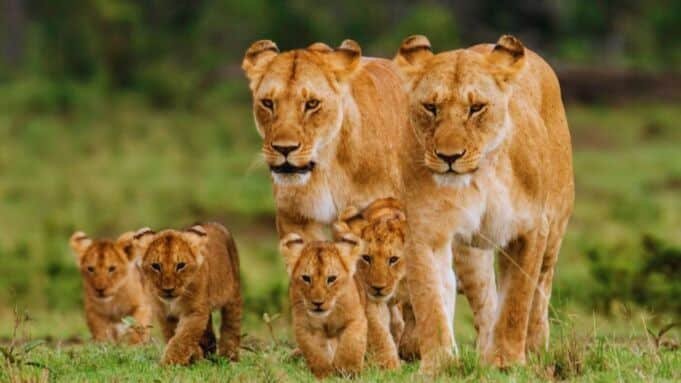East Africa is a dream destination for safari enthusiasts, offering some of the most iconic wildlife experiences in the world. This region’s jewels are Kenya and Tanzania, two countries renowned for their breathtaking landscapes, diverse wildlife, and rich cultural heritage.
Kenya and Tanzania Safaris promises unforgettable encounters with nature and highlights the importance of conservation efforts and sustainable tourism in preserving these precious ecosystems.
Iconic National Parks and Game Reserves
Kenya and Tanzania boast an array of world-famous national parks and game reserves that are must-visits for any safari itinerary.
Kenya’s Top Safari Destinations:
- Maasai Mara National Reserve: Known for its vast savannahs and abundant wildlife, including the Big Five (lion, elephant, buffalo, leopard, and rhinoceros), the Maasai Mara is a safari haven.
- Amboseli National Park: Set against the stunning backdrop of Mount Kilimanjaro, Amboseli is famous for its large herds of elephants and spectacular views.
- Tsavo National Park: Comprising Tsavo East and Tsavo West, this park is known for its rugged landscapes, diverse wildlife, and distinctive “red elephants” coated in the park’s red volcanic soil.
Tanzania’s Top Safari Destinations:
- Serengeti National Park: Synonymous with the Great Migration, the Serengeti offers endless plains teeming with wildlife and dramatic predator-prey interactions.
- Ngorongoro Crater: This UNESCO World Heritage site is a massive volcanic caldera with rich biodiversity, providing a microcosm of East African wildlife.
- Tarangire National Park: Renowned for its large elephant population, baobab trees, and seasonal migrations, Tarangire is a hidden gem in Tanzania’s safari circuit.
The Great Migration: A Cross-Border Spectacle
The Great Wildebeest Migration is one of nature’s most awe-inspiring spectacles, involving the movement of over two million wildebeest, zebras, and gazelles across the Serengeti and Maasai Mara ecosystems. This annual event sees the herds crossing the treacherous Mara River, braving crocodile-infested waters and predators on both sides.
The migration typically takes place between July and October in the Maasai Mara and from December to March in the Serengeti. Witnessing this phenomenon is a highlight of any safari in Kenya and Tanzania.
Diverse Wildlife Experiences in Kenya and Tanzania Safaris
While both countries offer exceptional wildlife viewing, each has unique experiences that set them apart.
Kenya:
- Balloon Safaris: Floating above the Maasai Mara at dawn provides a unique perspective of the landscape and wildlife below.
- Night Drives: Certain conservancies in Kenya allow night drives, offering glimpses of nocturnal creatures like hyenas and aardvarks.
Tanzania:
- Walking Safaris: Tarangire and the Serengeti offer guided walking safaris, allowing visitors to experience the bush up close.
- Birdwatching: Tanzania is a birdwatcher’s paradise, with over 1,100 species, including flamingos, vultures, and the elusive shoebill stork.
Combining Kenya and Tanzania Safaris
Combining safaris in Kenya and Tanzania offers a comprehensive East African adventure, maximizing wildlife sightings and diverse experiences.
- Experience the best of both worlds, from the Maasai Mara to the Serengeti, and beyond.
- A 10-14-day itinerary covering the Maasai Mara, Serengeti, Ngorongoro Crater, and Amboseli National Park provides a well-rounded safari experience.
- Fly between destinations or opt for guided overland tours to explore the stunning landscapes and wildlife.
Kenya Safari Cost
Kenya Safari Cost can vary significantly depending on several factors, including the time of year, the type of accommodation, and the length of the safari. Generally, a mid-range safari can cost between $300 to $500 per person per day, covering expenses such as park entry fees, accommodation, meals, and guided game drives. Luxury safaris, which offer more exclusive lodges, private guides, and additional amenities, can range from $600 to $1,500 or more per person per day.
Budget options, often involving camping and self-drive tours, can be as low as $100 to $250 per person per day. Additional costs may include international flights, visa fees, travel insurance, and optional activities such as balloon safaris or cultural visits. Planning and booking through reputable operators can help ensure a safari that matches your budget and expectations.
Kenya and Tanzania Safaris – Which is Better?

Choosing between Kenya and Tanzania safaris can be challenging, as both offer stunning landscapes, abundant wildlife, and unique cultural experiences, making each destination a premier safari adventure in East Africa. Here’s an informative and clear comparison table about “Kenya and Tanzania Safaris – Which is Better“:
| Feature | Kenya Safari | Tanzania Safari |
| Top Safari Destinations | Maasai Mara, Amboseli, Tsavo | Serengeti, Ngorongoro Crater, Tarangire |
| Great Migration | July to October (Maasai Mara) | December to March (Serengeti) |
| Wildlife Diversity | Big Five, large elephant herds, diverse birdlife | Big Five, large elephant herds, abundant predators |
| Scenic Highlights | Mount Kilimanjaro views (Amboseli), Mara River | Ngorongoro Crater, Serengeti Plains |
| Cultural Experiences | Maasai, Samburu, Kikuyu tribes | Maasai, Hadzabe hunter-gatherers |
| Accommodation Options | Luxury lodges, tented camps, budget lodges | Luxury lodges, tented camps, budget lodges |
| Unique Activities | Balloon safaris, night drives, walking safaris | Walking safaris, birdwatching, cultural tours |
| Accessibility | Better infrastructure, more accessible parks | Larger parks, slightly more remote locations |
| Best Time to Visit | June to October (dry season, Great Migration) | June to October (dry season, Great Migration) |
| Cost Range | $100 – $1,500+ per person per day | $100 – $1,500+ per person per day |
| Conservation Initiatives | Strong community and wildlife conservation efforts | Extensive conservation areas, numerous eco-projects |
| Popular Extensions | Kenyan coast (Mombasa, Diani Beach), Nairobi | Zanzibar beaches, Mount Kilimanjaro, Arusha |
| Visa Requirements | Visa on arrival or e-visa | Visa on arrival or e-visa |
Practical Tips for Planning Kenya and Tanzania Safaris
Planning a safari in Kenya and Tanzania is an exciting adventure that requires careful preparation to ensure a seamless and memorable experience. By following practical tips, you can navigate the logistics and maximize the enjoyment of your safari, ensuring that your journey through the wilds of Kenya and Tanzania is both safe and unforgettable.
- Choose the Best Time to Visit: Plan your safari during the dry seasons (June to October) for optimal wildlife viewing.
- Research Visa Requirements: Ensure you have the necessary visas for both Kenya and Tanzania, which can typically be obtained on arrival or through e-visas.
- Get Vaccinated: Consult your healthcare provider for recommended vaccinations, such as yellow fever, and take malaria prophylaxis.
- Pack Appropriately: Bring lightweight, neutral-colored clothing, sturdy shoes, a wide-brimmed hat, sunglasses, and a good camera.
- Book Through Reputable Operators: Choose well-reviewed tour operators who prioritize safety and responsible tourism.
- Consider Travel Insurance: Purchase comprehensive travel insurance covering medical emergencies, trip cancellations, and travel delays.
- Budget Wisely: Be aware of costs for park entry fees, accommodation, meals, and additional activities like balloon safaris or cultural tours.
- Stay Hydrated and Safe: Drink plenty of water, use insect repellent, and follow health and safety guidelines during your safari.
- Plan for Connectivity: Be prepared for limited internet access in remote areas, and inform family and friends of your itinerary.
Conclusion
A safari in Kenya and Tanzania is a journey of a lifetime, offering unparalleled wildlife encounters, cultural experiences, and breathtaking landscapes. Whether you’re witnessing the Great Migration, engaging with local communities, or simply enjoying the serenity of the African wilderness, these East African gems promise unforgettable memories and a deeper appreciation for nature.
















[…] accompanied by hundreds of thousands of zebras and gazelles. This epic movement spans the Serengeti in Tanzania and the Masai Mara in Kenya. River crossings are pivotal moments in this migration, as they […]
[…] Related: Diverse Wildlife Experiences in Kenya […]
Comments are closed.